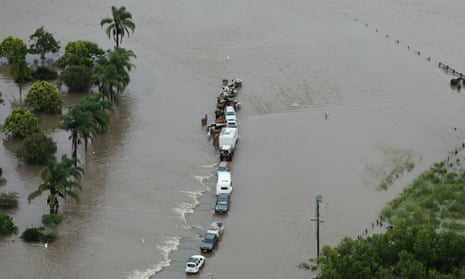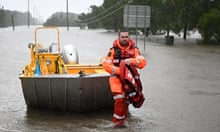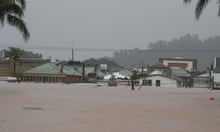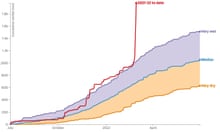Farmers have been left reeling by “devastating” losses of livestock and machinery amid severe flooding in south-east Queensland and northern New South Wales, with concern some may not be able to recover from the latest disaster.
Paul Weir, a Lismore dairy farmer, could only watch as half of his 300-cow herd were swept away by flood waters in the early hours of Monday morning.
“As the water came up they started like a crowd crush and popped a gate open,” Weir said.
It is the first time in the 28 years Weir has been running the farm that the property has been flooded. The previous record flood in 2017 did not reach it.
“The dairy and the cows were all above what we always considered was a safe spot,” Weir said.
But this time the extra two metres of water proved too much.
On Tuesday morning he had to shoot five injured cows and he expects many more have drowned.
Colin Thompson, the chair of the NSW Farmers dairy committee, said many other dairy farmers, especially around Richmond, were experiencing “devastating” impacts. It is too early to tell how much livestock has been washed away and the damage to equipment and infrastructure under water.
One surviving cow is gaining online notoriety after washing up at Duranbah beach in Tweed Heads, while another was seen on a roof in Lismore. The ABC reported that at least one had been found dead on Mermaid beach in the Gold Coast.
A cow on a roof in Lismore @9NewsAUS pic.twitter.com/owF8RHO7qH
— Sophie Walsh (@sophie_walsh9) March 1, 2022
Matt Dalgleish, an agricultural analyst for Thomas Elder Markets, said the combined estimate of cattle in the regions affected by flooding would amount to about 475,000, or about 2% of the national herd, according to Australian Bureau of Statistics calculations.
Dalgleish said an estimated 600,000 head of cattle had been lost in the flooding in far north Queensland in 2019 but the impact of this year’s flooding would depend on how widespread it was in cattle regions.
Shaughn Morgan, the co-chief executive of eastAUSmilk, the industry body representing dairy farmers in NSW and Queensland, said even dairy farmers whose cattle hadn’t been washed away were facing problems.
Without power, milking sheds could not be operated, he said, and cows could develop mastitis, three-day sickness or lameness. “These are issues that need to be addressed quickly,” he said.

Morgan said flooding was also making it difficult for milk tankers to get to farms, with some stuck on highways.
There had been “enormous” infrastructure losses including tractors, sheds, fencing, generators and irrigation equipment, as well as feed.
Weir said he had lost everything. He estimates the water damage bill to be $1.5m and expects to miss out on $180,000 in income a month.
“We’re in trouble the next three or four months,” he said. “I don’t know how Lismore is going to get over this. Every business in Lismore has been devastated. The people we would normally take these things to get repaired are cleaning up and repairing their own businesses.”
Morgan said: “Farmers need to be able to stay on the land. We need to make sure we don’t lose them.”
Paul Shoker, the chair of NSW Farmers’ Coffs Harbour branch, said the latest flooding could prove too much for some in the industry.
He said the region, which is a major producer of macadamias and blueberries, had experienced significant crop damage, waterlogged paddocks, landslips, lost livestock and damaged fences.
Shoker said his phone hadn’t stopped ringing with reports of damage from members since the area received 640mm of rain – more than 40% of their annual rainfall – in six days.
Farmers would attempt to salvage damaged crops but some plants would not recover as the waterlogging created fungus and disease.
Shoker, a banana and avocado farmer, said he had lost 300 avocado trees in the floods in March last year, a 10th of his total. While it was hard at this stage to assess the damage, he now expected “significant losses” of at least the same magnitude.
Farmers who were constantly being squeezed on prices did not have a buffer to cover increasingly frequent bad seasons, he said.
“Once upon a time farmers would have banked money from good seasons. Since the bushfires, these two floods, people haven’t had enough money from a good stretch to put away.”
The area had been hit by three disasters in three years while farmers “normally work off of one or two natural disasters in a decade”.
These came at the same time as rising costs of fertiliser, chemicals, fuel and wages.
Many farmers, Shoker said, especially those getting older, would be asking themselves if they could recover.









